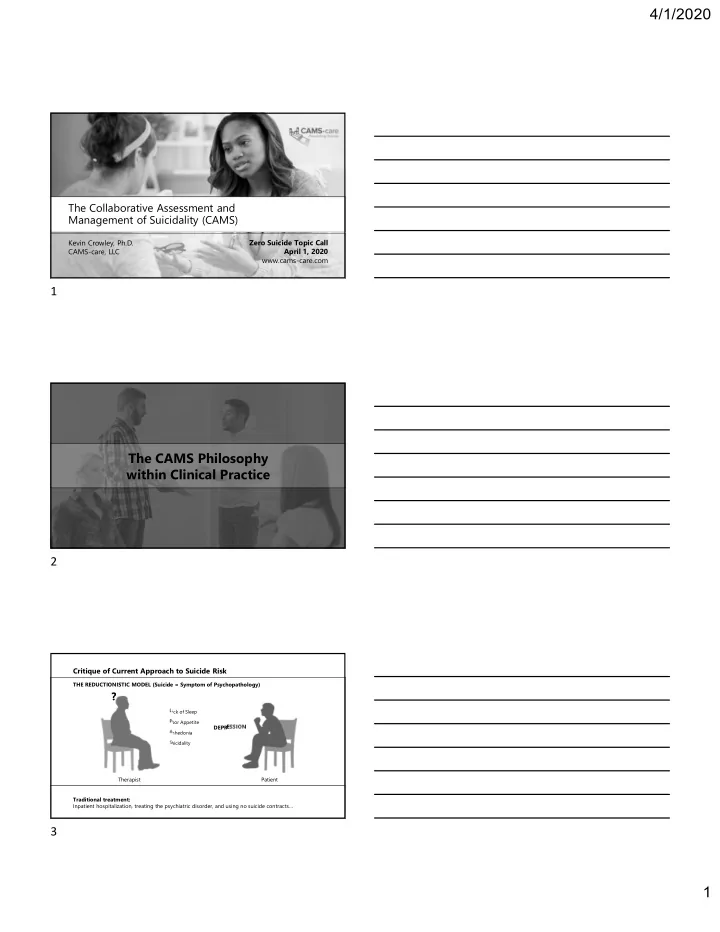

4/1/2020 The Collaborative Assessment and Management of Suicidality (CAMS) Kevin Crowley, Ph.D. Zero Suicide Topic Call CAMS-care, LLC April 1, 2020 www.cams-care.com 1 The CAMS Philosophy within Clinical Practice 2 Critique of Current Approach to Suicide Risk THE REDUCTIONISTIC MODEL (Suicide = Symptom of Psychopathology) ? Lack of Sleep Poor Appetite DEPRESSION Anhedonia Suicidality Therapist Patient Traditional treatment: Inpatient hospitalization, treating the psychiatric disorder, and using no suicide contracts… 3 1
4/1/2020 Traditional Clinician As Expert Engagement 4 CAMS for Assessment and Intervention Pain Stress Agitation Mood Suicidality Hopelessness Self-Hate Reasons for Living vs. Dying Therapist & Patient The Collaborative Assessment and Management of Suicidality (CAMS): Identifies and targets Suicide as the primary focus of assessment and intervention… 5 The CAMS Approach: Building a Strong Alliance and Increasing Patient Motivation 6 2
4/1/2020 What is DRIVING this person’s suicide risk? Direct Drivers : Indirect Drivers : Internal experiences, behaviors, and external Factors that make this person feel vulnerable situations that are associated with this to direct drivers being activated. person’s own acute suicidal crises (what is the “straw that breaks the camel’s back?” leading to suicidal behavior). • Examples include: negative life events, psychosocial stressors, psychiatric illnesses, isolating, not sleeping enough • These may be profoundly painful, they do not necessarily trigger acute crises but increase vulnerability (Jobes et al., 2011; Tucker et al., 2015) 7 Indirect Drivers ? Indirect Suicide as Driver(s)* an Option * Some examples of indirect drivers that inserted above include: Depression Substance Abuse Pending Deployment Marital Conflict Financial Difficulties Chronic Medical Issues Homelessness Relationship Problems Unemployment PTSD Symptoms Bad Grades Incarceration 8 Direct Drivers Indirect Direct Suicide as Driver Driver(s)* an Option * Direct drivers bridge the gap. They explain how this person gets from indirect drivers to considering/choosing suicide as an option. “A lot of people struggle with X, but not everyone who does wants to kill themselves. How are you seeing X that makes you feel like suicide is an option or the only option for dealing with it?” 9 3
4/1/2020 The Suicide Status Form (SSF): Connecting Theory to Practice 10 CAMS SSF Initial Session Section A: Completed by Patient • Risk Assessment SSF Core • Self or Others Assessment • Reasons for Living/Dying • Wish to Live/Die • One Thing 11 CAMS SSF Initial Session Section B: Completed by Clinician and Patient Section C: Completed by Clinician and Patient Stabilization Plan Treatment Plan 12 4
4/1/2020 CAMS SSF Initial Session Stabilization Plan: Completed by Clinician and Patient • Lethal means safety discussion • Coping strategies • Decrease isolation • Barriers to attending treatment 13 CAMS SSF Initial Session After completing Stabilization Plan: Return to Section C • Finish Treatment Plan • Complete Informed Consent • Patient and Clinician Sign SSF Patient is provided with copies 14 CAMS SSF Initial Session Section D: Completed by Clinician after session is completed with patient Patient’s Overall Suicide Risk: • Review Ratings for Wish to Live (WTL)/Wish to Die (WTD) • Review Reasons for Living (RFL)/Reasons for Dying (RFD) 15 5
4/1/2020 CAMS SSF Tracking/Update Interim Session(s) Section A: Completed by Patient within first few minutes of each session Complete Ratings • Review Stabilization Plan • • Target & Treat Drivers Review Treatment Plan • Section B: Completed by the clinician and patient at the end of each session Noting the completion of the stabilization • plan Identifying two problem drivers that cause • suicidality Note goals and objectives • Note interventions and duration • Both parties sign the form • 16 CAMS SSF Tracking/Interim Update Interim Session(s) Section C: Completed by Clinician • Mental Status Exam • Diagnostic Impressions • Overall Suicide Risk • Case Notes • Clinician Signature 17 CAMS SSF-4 Outcome/Disposition Final Session Criteria for Resolution of CAMS Section A Patient has had 3 sessions in a row with: Risk rating of suicide < 3 • No Suicidal Behaviors • Effectively Managed Suicidal • Thoughts/Feelings Focus: Lessons Learned • Coping Strategies • Section B Criterion are met • Note outcome disposition • Both parties sign the form • 18 6
4/1/2020 CAMS SSF-4 Outcome/Disposition Final Session Section C: Completed by Clinician after session is completed 19 First session of CAMS—SSF Assessment, Stabilization Planning, Driver-Specific Treatment Planning, and HIPAA Documentation CAMS Interim Tracking Sessions CAMS Outcome/Disposition Session 20 CAMS Interim Tracking - Start With Section A and End With Section B 21 7
4/1/2020 CAMS Therapeutic Worksheet 22 CAMS Therapeutic Worksheet 23 Plans, Goals, and Hope for the Future INSTILL hope MOVE beyond survival ENCOURAGE a positive future self FIND purpose and meaning IMAGINE a “post-suicidal” life 24 8
4/1/2020 A Stepped Care Model for Suicide Care Suicide-specific Care at Each Step From Least to Most Restrictive Intervention $$$ Stabilization Planning + CAMS Inpatient Psychiatric MI, PACT, Lethal Means Safety + ASSIP, TMBI Hospitalization caring follow-up used throughout the model Partial Hospitalization Mental Health Care Costs Emergency Respite Care Suicide-focused care that is: DBT, CT-SP, Outpatient Care • evidence-based BCBT • least-restrictive Brief Intervention + Follow-up • cost-effective Crisis Center Hotline Support + Follow-up Mental Health Service Corp—paraprofessionals (and people with lived experience) creating the necessary work force $ Adopted from Jobes, D. (2014) 25 CAMS Research Findings Summary Across 8 published non-randomized clinical trials of CAMS, 1 meta-analysis, and 4 published randomized controlled trials (with 1 unpublished 5 on-going RCT’s) Reduces suicidal ideation Changes suicidal cognitions CAMS Increases hope Positive patient experience Reduces ED visits Positive impact on self-harm/attempts Relatively easy to learn 26 On-line training + live role-playing + coaching calls + book = CAMS adherence www.cams-care.com 27 9
4/1/2020 Thank You! Find us online at: www.cams-care.com camscare.crowley@gmail.com 28 10
Recommend
More recommend